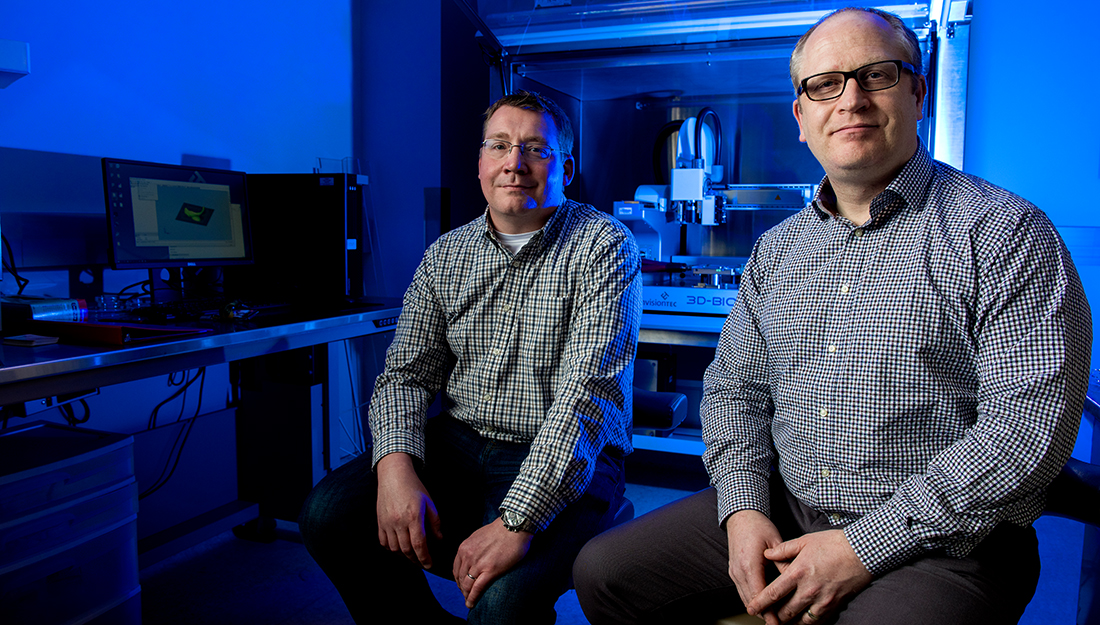- Christina Sumners
- Medicine, Research, Show on VR homepage
Collaborating to ‘scale up’ stem cell technology
Researchers in medicine and engineering are moving a bone-healing technology forward with the help of the university-level X-grants

Texas A&M University Health Science Center
When biomedical researchers have a technology they believe can help patients, they want to get it into the clinic as soon as possible. However, some therapies that look promising in the lab are challenging to ‘scale up’ and produce in sufficient quantities to test in a larger group, or eventually make broadly available to patients.
Carl Gregory, PhD, an associate professor in the Institute for Regenerative Medicine at the Texas A&M College of Medicine, found this out firsthand with his research using adult stem cells to repair bone. Now, with the help of a recently awarded X-Grant, he will be able to move the research to the next level.
Gregory’s earlier work found that injecting mesenchymal stem cells from donated human bone marrow—and an accompanying “biomatrix” of proteins that are usually found in young bone tissue—at the site of injury may improve healing.
To make the bone therapy available to humans, millions of cells per patient are required. To make things even more challenging, generating clinically relevant cells from donated human bone marrow is very difficult. “When you go up an order of magnitude in scale, then everything gets bigger and heavier, more expensive, and every source of error is going to compound,” Gregory said.
“We did one calculation, and found that for some specific resources, it would take more than exists in the entire world to make enough cells using currently accepted strategies,” Gregory added.
Another problem is that mesenchymal stem cells are usually made from donated human tissues, but these sources are finite and variable. An alternative approach is to use induced pluripotent (iPS) cells, a type of stem cell that can be made from adult cells. “They can theoretically divide an infinite number of times,” Gregory said, “but we’ve still run into difficulty manufacturing mesenchymal stem cells from iPS cells in large, clinically relevant batches.”
That’s where engineering comes in. Among the engineers Gregory collaborates with is Roland Kaunas, PhD, a biomedical engineer in the Texas A&M College of Engineering. “With the engineering philosophies of these members of our team, we had a head start,” Gregory said, “and now we’re just working on the fine-tuning.”
This fine-tuning involves, in part, a matrix that can help create the number of cells they need while simultaneously providing a scaffolding for the cells to grow. “Say you’re in the swimming pool—even if you can tread water, when you start to get tired, your tendency is to go to the side of the pool and hang on,” Gregory said. “Our cells tend to do that too, so if we can improve and expand the surfaces where cells tend to hold on, that will improve their functionality. By producing the matrix as small spherical cell microcarriers, we provide the cells with ‘floats’ to grab onto to maximize the growth area in bioreactors.”
Kaunas and Gregory are also 3-D printing scaffolds that mimic the structure of bone. The scaffolds can be developed to mimic the surface of the bones the stem cells grow on naturally in the body. They need to have a ‘spongy porosity’ of natural bone with complicated structures—all about the size of a single cell. “We can generate these with 3-D printing and the technology can create the same thing every time,” Gregory said. “We can also mix the materials with proteins like growth factors, or anything else we need, in the creation process.”
Kaunas added, “By coating these porous scaffolds with our biomatrix, we are providing an environment that coaxes stem cells to more rapidly heal bone.”
Next, Gregory is the lead investigator, with Kaunas a collaborator, on the X-grant award that will further this technology. The goal of that research is to establish a scalable way to produce cells for treating disease or healing injuries.
That scalable part of the equation is necessary for treatments to be helpful for an entire population. “In Europe, the use of adult mesenchymal stem cells is becoming standard treatment for certain autoimmune disorders, but there are only a few facilities that make these cells,” Gregory said. “Patients who need it can’t get it, so training people to start an industry is key.” He and Kaunas are working on that training portion as well, speaking with industry leaders to identify jobs that need qualified people and setting up training programs to get people ready for these positions.
“I personally believe that everything scientists do has to be translatable and everything has to be worth something to the general public,” Gregory said. “If you are developing a technology, from day one, you have to think about whether it’s scalable. If it’s not, then no matter how wonderful a therapy it is, it’s not going to be useful.”
Media contact: media@tamu.edu


